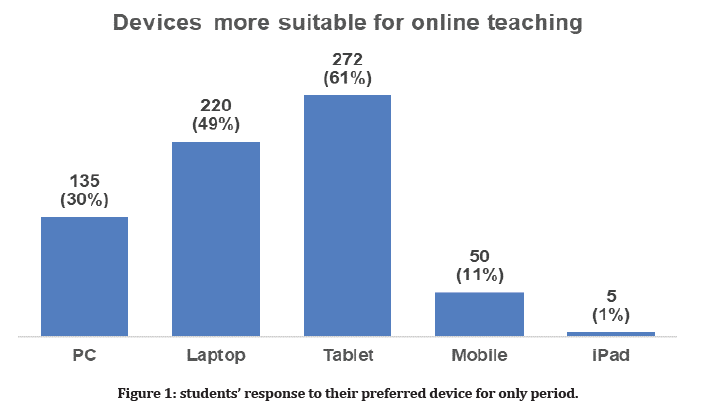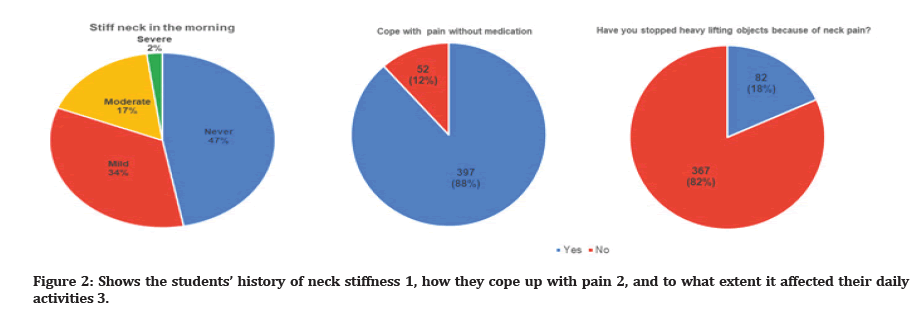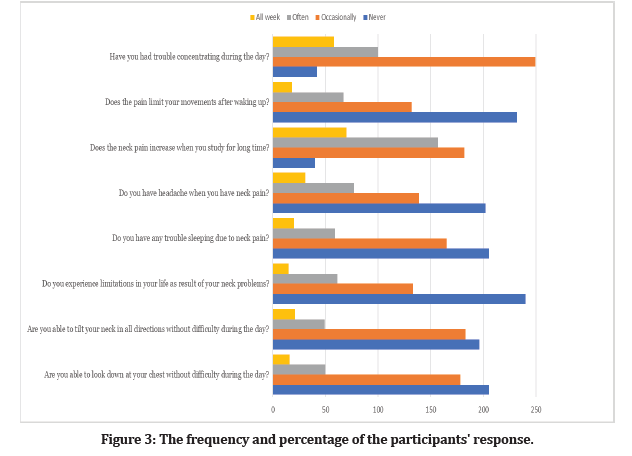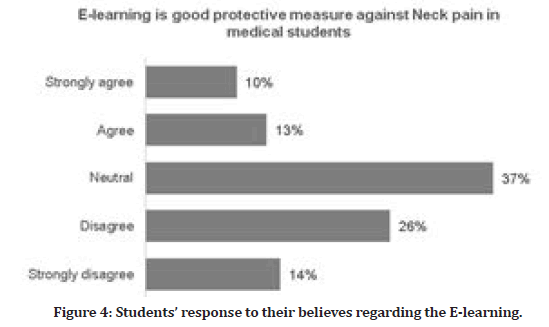Research - (2022) Volume 10, Issue 11
Neck Pain Among Medical Students in KSA After Applying Distance Education During COVID-19 Era
Mohammed H. Karrar Alsharif1*, Ali Hassan A. Ali2, Abdullah A. Alghamdi3, Yousef M. Alsomali3, Khalid Z. Aljulaifi3, Abdullah S. Alsayari3, Hamoud M. Almubki3 and Fahad A. Alzahrani3
*Correspondence: Mohammed H. Karrar Alsharif, Department of Basic Medical Science, College of Medicine, Prince Sattam Bin Abdulaziz University, Al Kharj,11942, Saudi Arabia, Email:
Abstract
Background: Neck pain is progressively becoming a health issue with significant socioeconomic consequences for individuals, their families, and communities. Neck pain is a substantial source of sickness, reduced educational performance, and absenteeism from university classes, all of which have an impact on student's future careers. Methods: The study used a cross-sectional design based on an electronic questionnaire for data collection. The study included a total of 449 college-level student participants. Around 262 (55%) participants were male, and 211 (45%) were female. In total, 53% of the students were from the private sector, and (82%) preferred the sitting position as their favorite study posture. Results: The prevalence of neck stiffness was high, and the overall impact was average, with students' mean score being 1.9 SD ±0.55. The females were more affected than the males, with a p-value of 0.015. over half of the students suffered from morning neck stiffness (53%), which varies from mild pain (34%), moderate (17%) and severe (2%). The pain was tolerable without using medications and did not significantly affect their quality of life. However, 20% of the students found it hard to study and do their daily activities without using meds. Conclusions: Our findings revealed a high preference for neck stiffness among medical students. Despite the fact that the majority can cope with the pain without medication, we cannot overlook 20% of the students who found it hard to study and do their daily activities without using meds and how it affected their quality of life.
Keywords
Neck Pain, Medical students, Distance education, COVID-19
Introduction
Neck pain (NP) is increasingly becoming a health problem and has a considerable socio-economic impact on individuals, their families, and communities [1,2]. Neck pain is a significant cause of sickness, reduced educational attainment, and truancy from university lessons, affecting students' future careers [1].
A medical school's principal aims are to produce capable, professional doctors and promote society's health care. However, during the period of medical training, they expose students to stress, study problems, and long training hours in hospital wards and clinics during the period of their medical practice [3]. Medical students seemed to have a higher risk of developing NP than the general population [4], especially now that medical schools recommended using online learning and applying distancing measures that subjected them to prolonged hours spent on different devices [5]. Besides the factors predisposing to pain in the general population, students subject themselves to hours of prolonged reading, writing, and clinical practice, which make them a highrisk group for NP. Furthermore, computer or tablet use is ubiquitous among medical students [6].
Previous studies have reported a high prevalence of NP in medical students. A study conducted at a Malaysian medical college found that 41.8% of students had NP within the past year and reported an association with clinical years, computer use, and a prior history of trauma [3]. Studies conducted in Pakistan, Australia, New York, the United States of America (USA), China, and Brazil found that 65, 52.8, 35, 33.8, and 8.23% of medical students had NP, respectively [7-11]. Another study in Central Saudi Arabia reported a prevalence of 56.5% for NP among medical students [12]. A Nigeria study revealed that the respondents' lifetime prevalence of NP was 34.9% [13].
Neck pain has a multi-factorial origin, and several factors are contributing to its onset and perpetuation. According to Guzman and his colleagues, physical, psychosocial, and individual-related factors were the most reported NP factors among medical students [14]. It can be caused by interference surrounding anatomical neck structures like nerve, airway, vascular, musculoskeletal, prolonged activity, poor posture, and previous neck injury [15].
Socio-demographic factors, for example, gender, age, body mass index (BMI), behavioural and psychosocial factors like smoking, drinking habit, physical exercise, stress, sleeping hours, physical factors, for instance, tablet or computer use, long sitting hours, seats without back supports, duration of reading, repetitive movements and awkward posture are considered as associated factors of NP among medical students Because of this in explicit pain, medical students undergo frequent sick leave, medical disability, functional impairments, decreased productivity, health cost, and absenteeism from university lessons [16-21].
Aim and objectives
To explore students' perceptions in medical schools about neck pain after the implementation of E-learning in KSA after the COVID-19 era.
Methodology
Study design
The study is a cross-sectional, exploratory study consisting of a quantitative (self-administered questionnaire). Data about medical students' perception of neck pain after implementing E-learning is compared with traditional or engagement teaching methods.
Methods
A predesigned questionnaire was developed following a thorough literature search; items will be explored using a five-point Likert scale (5=strongly agree, 4=agree, 3=I'm not sure, 2=disagree, 1=strongly disagree).
The questions were constructed after a systematic search in the literature using the search terms (COVID-19 and medical education/ COVID-19 and neck pain / COVID-19 and online teaching); the search was conducted in PubMed and Scopus during the period from April to Nov 2020 and included all types of articles in the English language published from 2020.
Sampling and sample size
The sample size was calculated by an online Open-epi calculator based on the predicted anticipated subjects. The assumption is that 20% of the population will participate in this study. This would give the study and 90% power to detect differences of 0.05 at the α-level.
Regarding the Data analysis, the Ordinal data obtained from the participant's responses to the questionnaire will be converted to quantitative data. The collected data will be analyzed using the Statistical Package of Social Sciences (SPSS). They will be summarized and presented as mean, median, standard deviation, and significance level set at the 95% confidence interval (CI).
Results
Characteristics of participants
The study included a total of 449 college-level student participants. Around 262 (55%) participants were male, and 211 (45%) were female. In total, 53% of the students were from the private sector, and (82%) preferred the sitting position as their favorite study posture. The results obtained from the analysis show that the students believe that tablets and laptops are the most suitable devices for E-learning, 1% & 49% respectively; nevertheless, approximately one-third of the participating students preferred using the PC (Table 1 and Figure 1) summarizes their demographic, academic, and preference.
| Count | % | ||
|---|---|---|---|
| Gender | Male | 251 | 55.90% |
| Female | 198 | 44.10% | |
| Medical school | Governmental | 199 | 44.30% |
| Private | 250 | 55.70% | |
| Level of study | Preparatory Year | 92 | 20.50% |
| 2nd year | 93 | 20.70% | |
| 3rd year | 91 | 20.30% | |
| 4th year | 42 | 9.40% | |
| 5th year | 81 | 18.00% | |
| 6th year | 50 | 11.10% | |
| Favorite body posture during the online sessions | Sitting | 368 | 82.00% |
| Lying | 81 | 18.00% |
Table 1: Demographic characteristics of participants.

Figure 1: students’ response to their preferred device for only period.
History of neck stiffness
An overview of data results shows that a great proportion of students suffered from morning neck stiffness (53%), of which around (34%) experienced mild pain, (17%) had moderate and only (2%) had severe neck stiffness. Even so, the pain was tolerable, and the majority was able to cope with or without using medications, and it did not stop them from either their daily activities or heavy lifting (Figure 2).

Figure 2: Shows the students’ history of neck stiffness 1, how they cope up with pain 2, and to what extent it affected their daily activities 3.
Neck stiffness effect on students during the lockdown
The overall effect of the neck stiffness was average, with a mean score of 1.9 SD ±0.55. It is apparent from the findings that the majority believe that stiffness increases with the increase of study hours, and it may affect their concentration while studying during the day (Figure 3).

Figure 3:The frequency and percentage of the participants' response.
The overall results also showed -to the majority- the students occasionally experience pain and movement limitations while trying to move or tilt their heads as a result of neck issues. It also affected their sleeping at night; occasionally, many participating students expressed neck pain early in the morning (Tables 2 and Table 3).
| Item | Mean | Median |
|---|---|---|
| Does the neck pain increase when you study for a long time? | 2.6 | 3 |
| Have you had trouble concentrating during the day? | 2.4 | 2 |
| Are you able to look down at your chest without difficulty during the day? | 1.7 | 2 |
| Are you able to tilt your neck in all directions without difficulty during the day? | 1.8 | 2 |
| Do you experience limitations in your life as a result of your neck problems? | 1.7 | 1 |
| Do you have a headache when you have neck pain? | 1.9 | 2 |
| Do you have any trouble sleeping due to neck pain? | 1.8 | 2 |
| Does the pain limit your movements after waking up? | 1.7 | 1 |
| 1. Never 2. Occasionally 3. Often 4. All week | ||
Table 2: Shows the means and median of the participants' scores.
| Item | Never | Occasionally | Often | All week |
|---|---|---|---|---|
| Are you able to look down at your chest without difficulty during the day? | 205 (45.66%) | 178 (39.64%) | 50 (11.14%) | 16 (3.56%) |
| Are you able to tilt your neck in all directions without difficulty during the day? | 196 (43.65%) | 183 (40.76%) | 49 (10.91%) | 21 (4.68%) |
| Do you experience limitations in your life as a result of your neck problems? | 240 (53.45%) | 133 (29.62%) | 61 (13.59%) | 15 (3.34%) |
| Do you have any trouble sleeping due to neck pain? | 205 (45.66%) | 165 (36.75%) | 59 (13.14%) | 20 (4.45%) |
| Do you have a headache when you have neck pain? | 202 (44.99%) | 139 (30.96%) | 77 (17.15%) | 31 (6.90%) |
| Does the neck pain increase when you study for a long time? | 40 (8.91%) | 182 (40.53%) | 157 (34.97%) | 70 (15.59%) |
| Does the pain limit your movements after waking up? | 232 (51.67%) | 132 (29.40%) | 67 (14.92%) | 18 (4.01%) |
| Have you had trouble concentrating during the day? | 42 (9.35%) | 249 (55.46%) | 100 (22.27%) | 58 (12.92%) |
Table 3: The frequency and percentage of the participants' response.
Factors Associated with neck stiffness
Variables potentially associated with neck stiffness among students were identified: gender, level of study, and favorite body posture. These variables were tested for associations with their responses to medication use, heavy lifting, studying for a long time, trouble concentrating during the day, experiencing neck stiffness at night or in the morning, and difficulties with head movements (Table 4).
| Item | Gender | Level of study | Favorite body posture |
|---|---|---|---|
| Can you cope with your pain without medication? | 0.751 | 0.619 | 0.812 |
| Have you stopped heavy-lifting objects because of neck pain? | 0.345 | 0.107 | 0.701 |
| How stiff is your neck when you have just woken up in the morning? | 0.208 | 0.018 | 0.552 |
| Does the neck pain increase when you study for a long time? | 0.000* | 0.269 | 0.606 |
| Have you had trouble concentrating during the day? | 0.015* | 0.976 | 0.337 |
| Are you able to look down at your chest without difficulty during the day? | 0.030* | 0.361b | 0.914 |
| Are you able to tilt your neck in all directions without difficulty during the day? | 0.067 | 0.055b | 0.083 |
| Do you experience limitations in your life as a result of your neck problems? | 0.075 | 0.020* | 0.063 |
| Do you have a headache when you have neck pain? | 0.031* | 0.67 | 0.757 |
| Do you have any trouble sleeping due to neck pain? | 0.121 | 0.323 | 0.26 |
| Does the pain limit your movements after waking up? | 0.011* | 0.011* | 0.066 |
| *: The Chi-square statistic is significant at the .05 level | |||
Table 4: Chi-Square association by the gender, level of study, and favorite body posture.
Gender
The findings revealed a significant association between gender and long-time study p-value 0.000. in addition, females suffered from neck stiffness more often than males. Even though both experienced difficulties with concentration, -for the majority- it was occasional, but females had experienced it more often than male’s p value 0.015.
The data also showed significant associations between the gender and headache, head tilting during the day, and head movements after waking up p values of 0.031, 0.030, and 0.011, respectively. However, based on gender, around 50% of all variables have not experienced these issues.
Level of study
Test for chi-square association shows a significant association between the level of the study and head tilting during the day and head movements after waking up p values 0.020* and 0.011*, respectively. However, less than 50% of the students have suffered or experienced neck stiffness during the lockdown period (Figure 4).

Figure 4: Students’ response to their believes regarding the E-learning.
Favorite body posture
The sitting position is the preference for most of the students during the online period; however, chi-square showed no significant association.
Discussion
Ever since the pandemic era and the impact it cost on medical education, there has been a move toward E-learning as a strategy to overcome this obstacle [22]. The study aimed to test the effect of neck stiffness during the covid 19 eras and its impact on online learning and quality of life. Our findings revealed a high preference for NS among medical students, which supports the findings of another study conducted by AlZarea, et al. which mentioned very high NS prevalence (77%) [23]. It is apparent from the findings that over half of the students reported suffering from NS, of which around 19% experienced mild and severe pain. These findings may explain why around 18% of the students preferred to study while lying on a couch, floor, or bed. Even though that approximately 80% of the participants do not use medications and can cope with the pain, we cannot ignore the fact that a considerable number of the students, 20%, find it hard to study and do their daily activities without using meds.
In response to how NS affects their concentration, very few students reported that they did not have trouble concentrating during the day, while many have found it quite often, 22.27% and around 12% had issues with concentration all week, especially those who study for a long time. When the participants were asked how it affected their life, the majority commented that the effect on their day and sleeping is occasional. However, we cannot ignore the great percentage of the students who suffered from NS all week or at least quite often, which may have led them to decrease their daily study hours. Only a few participants expressed their beliefs about the impact of E-learning and how it was considered an excellent protective measure against Neck pain in medical students during the lockdown era (Figure 4). These results provide important insights into these matters and how they may affect students’ productivity and quality of life.
In the current study, the findings revealed a significant association between gender and NS. It is apparent from the findings that the females suffered from neck stiffness more often than males and experienced more difficulties with concentration, headaches, and tilting than males. This might be due to the fact that females spend more study hours than males, which on the other hand, could be related to cultural reasons where females spend more hours at home than males.
In the current study, a small disparity was found between the responses regarding the level of education and favorite posture, where few differences were found. However, the findings indicated no signification association.
Conclusion
Few studies were conducted in Saudi Arabia regarding the impact of NS on the student's performance and quality of life. Our findings revealed a high preference for NS among medical students. Despite the fact that the majority can cope with the pain without medication, we cannot overlook 20% of the students who found it hard to study and do their daily activities without using meds and how it affected their quality of life.
Acknowledgement
This publication was supported by the Deanship of Scientific Research at Prince Sattam bin Abdulaziz University, Alkharj, Saudi Arabia.
Authors Contributions
This work was performed in collaboration with all authors. They designed the study, collected and processed questionnaires, created the manuscript, and approved the final version of the manuscript.
Conflict of Interests
The authors declare that there are no conflicts of interest.
Availability
The data are available upon request from the authors.
References
- Rose KA. The effect of neck pain and headaches on the academic performance of college students. J Neuromusculoskeletal System 2000; 8:118-123.
- Buckle P. Ergonomics and musculoskeletal disorders: Overview. Occup Med 2005; 55:164–167.
- Dasari V, Dasari K. Nutraceuticals to support immunity: COVID-19 pandemic-a wake-up call. J Clin Diagnostic Res 2020; 14.
- Alshagga MA, Nimer AR, Yan LP, et al. Prevalence and factors associated with neck, shoulder and low back pains among medical students in a Malaysian medical college. BMC Res Notes 2013; 6:244.
- Crawford RJ, Volken T, Schaffert R, et al. Higher low back and neck pain in final year Swiss health professions' students: Worrying susceptibilities identified in a multi-Centre comparison to the national population. BMC Public Health 2018; 18:1188.
- Alsharif MH, Gasmalla HE, Almasaad JM, et al. Online anatomy education in the COVID-19 pandemic: Challenges and suggested practices as per student and faculty experiences in the Saudi Arabia and United Arab Emirates. Educ Med J 2022; 14.
- Noack-Cooper KL, Sommerich CM, Mirka GA. College students and computers: Assessment of usage patterns and musculoskeletal discomfort. Work 2009; 32:285–298.
- Du JY, Aichmair A, Schroeder JE, et al. Neck pain and low back pain in medical students: A cross-sectional study. Int Arch Public Health Community Med 2017; 1.
- Hasan MM, Yaqoob U, Ali SS, et al. Frequency of musculoskeletal pain and associated factors among undergraduate students. Case Rep Clin Med 2018; 7:131.
- Smith DR, Leggat P. Prevalence and distribution of musculoskeletal pain among Australian medical students. J Musculoskeletal Pain 2007; 15:39–46.
- Smith DR, Wei N, Ishitake T, et al. Musculoskeletal disorders among Chinese medical students. Kurume Med J 2005; 52:139–146.
- Silva AL, Smaidi K, Pires MHR, et al. Prevalence of chronic pain and associated factors among medical students. Revista Dor 2017; 18:108–111.
- Algarni AD, Al-Saran Y, Al-Moawi A, et al. The prevalence of and factors associated with neck, shoulder, and lowback pains among medical students at university hospitals in Central Saudi Arabia. Pain Res Treat 2017; 2017:1235706.
- Ayanniyi O, Mbada CE, Iroko OP. Neck pain occurrence and characteristics in Nigerian University undergraduates. TAF Preventive Med Bull 2010; 9:167–74.
- Guzman J, Haldeman S, Carroll LJ, et al. Clinical practice implications of the bone and joint decade 2000– 2010 task force on neck pain and its associated disorders. Eur Spine J 2008; 17:199–213.
- Pope MH, Goh KL, Magnusson ML. Spine ergonomics. Annu Rev Biomed Eng 2002; 4:49–68.
- McLean SM, May S, Klaber-Moffett J, et al. Risk factors for the onset of non-specific neck pain: A systematic review. J Epidemiol Community Health 2010; 64:565–572.
- Malik A, Pasha M, Khalid S, et al. Prevalence of neck pain among undergraduate students of Lahore. Int J Scientific Engineering Res 2017; 8:569–576.
- Diepenmaat A, Van der Wal M, De Vet H, et al. Neck/shoulder, low back, and arm pain in relation to computer use, physical activity, stress, and depression among Dutch adolescents. Pediatrics 2006; 117:412–416.
- Nilsen TIL, Holtermann A, Mork PJ. Physical exercise, body mass index, and risk of chronic pain in the low back and neck/shoulders: Longitudinal data from the Nord-Trøndelag health study. Am J Epidemiol 2011; 174:267–273.
- Ayaz SB, Malik R, Khan AA, et al. Intensity of neck pain secondary to excessive flexion posturing, its association with study activities and duration of posturing and impact on sleep in students of women medical college. Abbottabad Editorial Advisory Board 2016; 66:22.
- Bernaards CM, Ariëns GA, Hildebrandt VH. The (cost-) effectiveness of a lifestyle physical activity intervention in addition to a work style intervention on the recovery from neck and upper limb symptoms in computer workers. BMC Musculoskelet Disord 2006; 7:80.
- Alsharif MH, Gasmalla HE, Elamin AY, et al. In light of COVID-19 crisis: Proposed guidelines for the "New Norm" of anatomy teaching. Med Sci 2020; 3281-3290.
- AlZarea BK, Patil SR. Mobile phone head and neck pain syndrome: Proposal of a new entity. Headache 2015; 251:63.
Indexed at, Google Scholar, Cross Ref
Indexed at, Google Scholar, Cross Ref
Indexed at, Google Scholar, Cross Ref
Indexed at, Google Scholar, Cross Ref
Indexed at, Google Scholar, Cross Ref
Indexed at, Google Scholar, Cross Ref
Indexed at, Google Scholar, Cross Ref
Indexed at, Google Scholar, Cross Ref
Indexed at, Google Scholar, Cross Ref
Indexed at, Google Scholar, Cross Ref
Indexed at, Google Scholar, Cross Ref
Indexed at, Google Scholar, Cross Ref
Author Info
Mohammed H. Karrar Alsharif1*, Ali Hassan A. Ali2, Abdullah A. Alghamdi3, Yousef M. Alsomali3, Khalid Z. Aljulaifi3, Abdullah S. Alsayari3, Hamoud M. Almubki3 and Fahad A. Alzahrani3
1Department of Basic Medical Science, College of Medicine, Prince Sattam Bin Abdulaziz University, Al Kharj,11942, Saudi Arabia2Department of Anatomy, Faculty of Medicine, Al-Azhar University, Cairo, Egypt
3College of Medicine, Prince Sattam Bin Abdulaziz University, Al Kharj 11942, Saudi Arabia
Citation: Mohammed H Karrar Alsharif, Ali Hassan A Ali, Abdullah A Alghamdi, Yousef M Alsomali, Khalid Z Aljulaifi, Abdullah S Alsayari, Hamoud M Almubki, Fahad A Alzahrani, Neck Pain among Medical Students in KSA after Applying Distance Education during COVID-19 Era, J Res Med Dent Sci, 2022, 10 (11): 88-93.
Received: 25-Oct-2022, Manuscript No. JRMDS-22-78144;; , Pre QC No. JRMDS-22-78144(PQ);; Editor assigned: 27-Oct-2022, Pre QC No. JRMDS-22-78144(PQ);; Reviewed: 10-Nov-2022, QC No. JRMDS-22-78144(Q); Revised: 15-Nov-2022, Manuscript No. JRMDS-22-78144(R); Published: 22-Nov-2022
